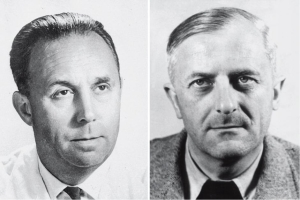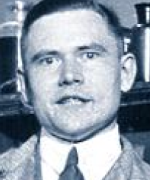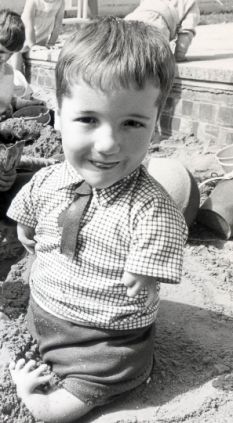“From the Holocaust to Thalidomide: A Nazi Legacy”

“How Men Who Blighted Lives of thousands Evaded Justice.” The post-WWII horror story of thalidomide begins in the picture-book town of Stolberg, near Aachen, in western Germany, with the establishment of Chemie Grünenthal, a Wirtz family-owned pharmaceutical company. After WWII, Nazi scientists stared down their pasts and searched for career opportunities; they gravitated toward fiercely competitive industries whose operations were shrouded in secrecy. One such hospitable industry was pharmaceuticals; they were able to channel their criminally acquired expertise to the development of drugs.
“By the mid-1950s, pharmaceutical makers were kings in a borderless business where profit often trumped politics and morality that caused a dangerously untested drug to be inflicted on the world. The result was that thousands of innocent babies suffered death and misery on a scale not seen since wartime. Those responsible have gotten away with it. (Andrew Rule. The Last German War SecretHerald Sun, 2011)
“The Nazi connection to thalidomide [demonstrates that] despite the Nuremberg trials and the development of ethical principles to guide research, we haven’t yet gotten it…there are still ongoing genocides throughout the world, either related to historic ethnic rivalries or, more often, related to money and greed. There are still major ethical abuses in conducting clinical trials. We seem to be confronted almost daily by evidence of our mistakes. What more will it take for us to learn and put people and ethics above power and profits?” (Judy Stone. Scientific American, Nov. 2012)
It was marketed as a ‘wonder drug’ between 1957 and 1962, and aggressively marketed in 46 countries using more than 39 brand names, including the most widely known “Contergan.” Although the drug was never tested in pregnant animals, the pharmaceutical companies that marketed this over-the counter drug advertised that it can be “given with complete safety to pregnant women and nursing mothers without any adverse effect on mother and child.” They distributed free samples throughout the world.

“For nearly half a century, the privately owned company was silent and secretive about the epic tragedy it created while earning a vast profit. Even before its release, the wife of an employee gave birth to a baby without ears, but Chemie Grünenthal ignored the warning. Within two years, an estimated million people in West Germany were taking the drug on a daily basis.” (Roger Williams. The Nazis and Thalidomide: The Worst Drug Scandal of All Time, Newsweek, September 2012)
“The dark shadow of thalidomide is still with us…war apart, it remains the greatest manmade global disaster. Now evidence has been uncovered that the pharmaceutical outrage – it is nothing less – was compounded by a judicial scandal that has suppurated all these years. It is exposed in a large number of documents discovered in the state archives of North Rhine-Westphalia by a researcher for the UK Thalidomide Trust. The papers, which have been examined and authenticated by the international law firm of Ince & Co, speak to political interference that violated the constitutional division of power between the legislative, the executive and the judiciary.
And more than half a century since the pill’s threat to an embryo was proven the company that produced the first disaster has continued to sell the drug in parts of Latin America, on prescription only, where babies continued to be born with malformations similar to the survivors from the 1960s…” (Harold Evans. Thalidomide: How Men Who Blighted Lives of thousands Evaded Justice, The Guardian, Nov. 2014)
Evidence of thalidomide’s Nazi roots
For decades Grünenthal officials adamantly denied that thalidomide had been developed during WWII. The company has insisted that three of its scientists developed Contergan /thalidomide in 1952 with no connection to Rohne-Poulenc. However, recently uncovered documents dated 1944 and 1946, contradict their assertions and confirm long-held suspicions that thalidomide was developed by Nazis who tested the drug on concentration camp victims (Andrew Levy. Nazis Developed Thalidomide And Tested It On Concentration Camp Prisoners, Author Claims, Daily Mail, Feb. 2009)
In his 2012 Newsweek article, Roger Williams exposed a previously unmentioned dark dimension of the company that precipitated this catastrophic far-reaching drug-induced tragedy.
“Adding to the dark shadow over the company, it is increasingly clear that, in the immediate postwar years, a rogues’ gallery of wanted and convicted Nazis, mass murderers who had practiced their science in notorious death camps, ended up working at Grünenthal, some of them directly involved in the development of thalidomide.
What they had to offer was knowledge and skills developed in experiments that no civilized society would ever condone. It was in this company, that a group of men, indifferent to suffering and believers in a wretched philosophy that life is cheap, who that thalidomide was developed and produced.” (“The Nazis and thalidomide: The Worst Drug Scandal of All Time” 2012)
- Martin Staemmler, a leading proponent of “racial hygiene” who worked with the SS in occupied Poland, selecting who should live, who should die. At Grünenthal, he headed pathology during the marketing of thalidomide.
- Another “racial hygiene” enthusiast who was hired by Wirtz was Hans Berger-Prinz who worked with Carl Brandt, the lead defendant in the Nuremberg Doctors’ Trial.
- Dr. Ernst-Günther-Schenck, a uniformed Nazi whose nutrition experiments killed many concentration camp prisoners; he was barred from practicing medicine in Germany.
- Dr. Heinz Baumkötter, an SS Hauptsturm-Führer, was the chief doctor at Mauthausen concentration camp, and most notoriously, from 1942 on he was chief medical officer in Sachsenhausen. In 1946 he was sentenced to life imprisonment by the Soviet Union, but returned to Germany in 1956 and employed by the Wirtz family at Grünenthal.
- Otto Ambros, co-inventor of the nerve gas sarin. He was a brilliant chemist and one of the most powerful industrialists who was Hitler’s adviser on chemical warfare. His crimes were on a grand scale as senior chemist in IG Farben; he set up a slave labor camp to produce deadly nerve gases prior to creating the Auschwitz chemical factory for synthetic rubbers. He was found guilty at Nuremberg of mass murder and enslavement; sentenced to eight years in prison, but was set free after four years by U.S. High Commissioner in Germany, John McCloy, who also restored Ambros’ substantial wealth.
As Roger Williams states: “Having covered up so much of his own past, he could bring his skills to bear in attempts to cover up the trail that led from the production of thalidomide back through its hasty trials to any origins it may have had in the death camps.” [Newsweek, 2012 ]
- Dr. Heinrich Mückter whose expertise had been anti-typhus vaccine research which was a Nazi army priority. Because typhus cannot live outside a body, it was injected into concentration camp prisoners who could then be used to test vaccine efficacy. Mückter’s experiments were reportedly carried out in Auschwitz, Buchenwald, and Grodno as well as at Kraków; he was responsible for the deaths of hundreds of prisoners and was wanted at the end of the war by the Polish authorities. But he was lucky to be caught by the Americans who provided an “Iron Curtain drawn across his past.” Grünenthal offered Mückter an opportunity to continue his work. [Newsweek, 2012]

During the War, Otto Ambros was a senior chemist at IG Farben; he was also a member of the managing board. IG Fraben was the chemical and pharmaceutical giant involved in multiple war crimes. Ambros worked closely with Gerhard Schrader, an IG Farben chemist who specialized in organophosphate insecticides. Schrader is credited with discovering lethal nerve gas agents – Tabun, Sarin, Soman, and Cyclosarin. Both men are credited as co-discovering Sarin’s lethal effect in humans, even at extremely low doses. Hitler proposed its use as a weapon.

In 1939, Schrader worked at the Rhone-Poulenc lab which was under Nazi control during the war years serving as a chemical plant producing mass amounts of war-grade, Sarin.
Documents uncovered by Argentinian investigative reporter, Carlos De Napoli, author of the book Hitler’s Laboratories, show that in 1939, Ambros was given the task of developing an antidote to sarin. He joined Schrader at Rhone-Poulenc and together, they conducted experiments on humans and animals, at Rohne-Poulenc and at other locations, gathering information on their antidote drug. During their testing of the compound as an antidote to nerve gas, the scientists noted that it was also a very effective sedative and tranquilizer, and that it was impossible to overdose on it. That “effective sedative” was thalidomide. (James Linder Jones MD. Thalidomide – The Real Story, Health World Net, 2011)
An IG Farben memorandum dated 1944 confirms tests completed
The memo confirms that the nerve gas antidote, at the time designated as “drug #4589” later marketed as “Contergan” had been tested on concentration camp prisoners. The memo dated 1944, from IG Farben director Fritz ter Meer, to Karl Brandt informed him that the drug – #4589 –“has been tested and is ready for use.” (Daily Mail, 2009; Linder, 2011)
[Brandt was Hitler’s physician who ran the so-called “euthanasia” program—i.e., the murder of people with disabilities whom the Nazis designated as “worthless eaters.” Brandt was the lead defendant at the Nuremberg Doctors Trial who was executed. Ambros and Schrader were convicted of war crimes for their ghastly human experimentation. Ambros was sentenced to eight years in prison, but was released after four years, when he went to work for Grünenthal where he became chairman of its advisory committee at the time of the development of thalidomide, and he was on the board when Contergan was marketed.]
A 1946 document confirmed thalidomide’s Nazi incubation origin.
A 1946 memo from the Swedish pharmaceutical, Astra Laboratories, which bought the rights to the drug’s Scandinavian marketing where it was sold under the name Neurosedyn, informs its Norwegian subsidiary:
“We cannot use the name Contergan in your area as rights to the name and the right to distribute it was sold to Grünenthal in an agreement with Rhone-Poulenc shortly after the war. (Linder, Thalidomide – The Real Story, 2011)
The memo thus confirms that thalidomide was developed by Rhone-Poulenc which sold its rights, including its trade name Contergan, to Grünenthal. Dr. Johnson, who runs Britain’s Thalidomide Trust, points out that Grünenthal’s 1954 thalidomide patent application states that the drug had already been tested in humans, but provides no documentation about those trials. Grünenthal claimed it had lost the documents relating to the thalidomide trials, but Johnson disputes their claim, noting that:
“The patents suggest that thalidomide was probably one of a number of products developed at [the chemical laboratory] Dyhernfurth or Auschwitz-Monowitz under the leadership of Otto Ambros in the course of nerve gas research…It is now appearing increasingly likely that thalidomide was the last war crime of the Nazis.”
De Napoli is convinced as well: “There is absolutely no doubt of the Nazi development of, and experimentation with, thalidomide in the World War Two camps.”
Disabled German children were another unconscionable testing ground for thalidomide:
In the 1950s, Thalidomide was tested in 140 children at University Clinic in Bonn, West Germany: seven children were less than a year old.
“The parents were not asked for their permission, nor were they informed that their children were being treated with an entirely new sedative. Doses used were 11 to 20 times higher than the recommended dose for adults; half the children were mentally disturbed or had brain damage. Other children also received Thalidomide in high doses; one child had a circulatory collapse, one died from a congenital heart defect, a three-month-old baby died from heart failure, a twenty- one-month-old baby temporarily lost her vision. The doctor responsible stopped using the drug when he heard that his medical colleagues had similar experiences with Thalidomide.”
(Bette Overell. Animal Research Takes Lives: Humans and Animals Both Suffer, 1993; Ann Lewis. Children of Thalidomide, 2014)
Thalidomide was marketed without safety tests; despite warnings
The drug was marketed within three years from its patent – 1954– 1957 – which is highly unusual—especially because it was not a life-saving treatment. But then again, the company failed to conduct proper clinical tests.
In 1955, Before the start of marketing, three physicians took part in a symposium arranged by Chemie Grünenthal at which they reported unsatisfactory experiences with Thalidomide. However, these reports were ignored and Thalidomide was aggressively marketed as a ‘wonder drug’ for insomnia, headache, cough, and worst of all, it was promoted for use by pregnant women to alleviate morning sickness. Thalidomide wreaked havoc to the developing fetus, causing catastrophic malformations.
Christmas Day, 1956: The wife of a Grünenthal chemist, who had been given samples of the drug for his wife, gave birth to the first deformed thalidomide baby who was born without arms, and only flipper-like hands. The condition is known as phocomelia, Greek for seal arms. It should have raised alarm but no one at the company wanted to hear or see any warning signs.
Grünenthal documents recently uncovered in the course of litigation in Australia, reveal a Fifty-Year Global Cover-Up. Grünenthal officials, in particular Otto Ambros who had tested the drug at Rhone-Poulenc, would have known the drug’s dangerous side effects. He was Chairman of Grünenthal’s thalidomide advisory committee at the time the drug was in development; and he was an active member of the company’s board of directors when the drug was being aggressively marketed in 46 countries using more than 39 brand names. Within four years of its marketing, an estimated 100,000 pregnant women and their unborn babies suffered catastrophic harm.

One of the first to suspect Thalidomide’s danger was a young German lawyer in Hamburg named Karl Shulte-Hillen. Both his sister and sister-in-law had given birth to babies with phocomelia – Greek for seal limbs. Since this had not been observed before, he wondered whether some contaminant in Hamburg might have affected the babies.
 Thalidomide babies were born with severe teratogenic deformities
Thalidomide babies were born with severe teratogenic deformities
Many of the babies were born with short malformed limbs resembling seal flippers; others had missing toes, fingers, arms and legs. Still others were born with malformed ears, eyes, and the nerve supplies to the face and eye muscles. The most severe malformation involved internal organ defects as well as malformed or missing limbs; commonly affecting the heart, kidneys, urinary tract, the genitals, and digestive tract. (Detailed description in Journal of Medical Genetics) Thalidomide’s mechanism of action is thought to be its inhibition of new blood vessel formation. The deformities are believed to have occurred because the fetus could not generate a blood supply to the developing new limb buds. There is still no explanation why animals had no observable effects from Thalidomide. No sedation, no deformities. This raises an important caveat about the reliability of animal research findings when testing the safety of new drugs.
The drug caused at least 90,000 miscarriages and 20,000 severely deformed infants; an estimated 5,000 to 7,000 deformed thalidomide babies were born in Germany; at least 2,000 in the UK. The death rate was 40% within the first year attributed mostly to severe internal malformations. Thalidomide, sold as Distaval was the worst drug-related catastrophe.
Some midwives [and doctors] deliberately let limbless babies die. Some parents went mad or committed suicide or abandoned their infants to charities or the state. Others resigned themselves to lives of quiet desperation and anonymous heroism. (Last German War Secret, 2011)
This entirely preventable catastrophe was the consequence of corporate greed and callous and pharmaceutical scientists’ and executives’ disregard for human life. This is demonstrated when, in 1958, Grünenthal sent a letter to 40,000 physicians encouraging the use of Thalidomide in pregnant women:
“In pregnancy and during the lactation period the female organism is under great strain. Sleeplessness, unrest and tension are constant complaints. The administration of a sedative and a hypnotic that will hurt neither mother nor child is often necessary.” (Overell, 1993)
By 1959 numerous reports to the company indicated that the drug was toxic; scores of adults suffered from drug-induced peripheral neuritis damaging the nervous system. Chemie Grünenthal suppressed that information, bribing doctors and pressuring critics and medical journals for years. (Newsweek, 2012) August 1959: A letter from Pharmakolor AG, a pharmaceutical company based in Basel, Switzerland:
“To date 20 well-known doctors have told our representatives that when they themselves or their patients took one tablet of thalidomide they found themselves still under its effects the next morning, suffering from considerable sickness, and involuntary trembling of hands.” (Russell Mokhiber. Multinational Monitor, 1987)
Sept. 1959: Use of Thalidomide was stopped at a German hospital because of severe reactions. Nov. 1959: Dr. Ralf Voss, a nerve specialist in Dusseldorf reported adverse effects and asked if it could damage peripheral nervous system. Grünenthal responded “Happily, such disadvantageous effects have never been observed before.”
At the same time that the company was receiving numerous reports of thalidomide’s toxic effects to the nervous system, officials stepped up its promotional campaign to sustain Thalidomide was a gold mine. In 1960, it sent out 250,000 leaflets extolling thalidomide and encouraging its use by pregnant women: can be “given with complete safety to pregnant women and nursing mothers without any adverse effect on mother and child…Outstandingly safe… “completely harmless for infants” and “harmless even over a long period of use.”
 Many German physicians told Grünenthal staff about their concerns that children’s deformities were caused by women taking thalidomide during pregnancy. Grünenthal denied the existence of information to suggest the drug was unsafe. Their denial is contradicted by the company’s own file noting that ”eight families [ ] dependents of the Chemie Grünenthal Company, during the years between 1959 until 1961, had had deformed children”. (Sydney Morning Herald,2012)
Many German physicians told Grünenthal staff about their concerns that children’s deformities were caused by women taking thalidomide during pregnancy. Grünenthal denied the existence of information to suggest the drug was unsafe. Their denial is contradicted by the company’s own file noting that ”eight families [ ] dependents of the Chemie Grünenthal Company, during the years between 1959 until 1961, had had deformed children”. (Sydney Morning Herald,2012)
Of considerable embarrassment for the countries that had approved the drug, was the fact that Communist East Germany had rejected the drug, because they concluded that it lacked a scientific rationale, and “cannot be considered an indispensable drug.” The East German government thereby spared its population the tragedy of thousands of deformed babies being born. In 1960, the U.S. marketer of thalidomide, Merrell, submitted a marketing licensure application to the FDA extolling the safety of the drug. But Dr. Frances Oldham Kelsey, a new FDA safety officer refused to approve its marketing in the U.S. because of insufficient testing of the drug and her concern about the warning signs of peripheral neuritis. In all, Dr. Kelsey rejected the drug’s marketing application five times. [Dr. Kelsey is one of AHRP’s heroes]
In 1961, Dr. William McBride, an Australian obstetrician wrote a letter published in The Lancet alerting physicians to the links between the epidemic of birth defects and thalidomide. At the same time, Dr. Widukind Lenz, a German pediatrician, drew the same connection between the drug and nearly 4,000 deformed babies that he had seen. [Dr. Lenz was the son of the infamous Nazi Dr. Fritz Lenz who had conducted genetics experiments on prisoners of war.]
Though the degree of exposure to attacks for Dr. Lenz and Dr. Kelsey differed – inasmuch as she was an FDA officer – they nevertheless faced similar threats to their professional credibility and personal integrity. Lenz faced sharpest criticism when he gave expert testimony during a lengthy court trial; whereas the FDA prevented Kelsey from testifying. (Arthur Daemmrich. Thalidomide and Political Engagement, Social History of Medicine, 2002)
Thalidomide References
Richard Baker, Nick McKenzie Australian women were thalidomide guinea pigs The Canberra Times, July 27, 2012
Dhristine Chisholm. Thinking about Thalidomide in Transnational History: Canada and South Africa, Active History, Oct 2014
Arthur Daemmrich A Tale of Two Experts: Thalidomide and Political Engagement in the United States and West Germany, Social History of Medicine, 2002
Carlos De Napoli. Hitler’s Laboratories,
Frederick Dove. What’s Happened to Thalidomide Babies? BBC News, Nov 2, 2011
Harold Evans. How Men Who Blighted Lives of Thousands Evaded Justice, The Guardian, 2014
Harold Evans. Thalidomide’s Big Lie Overshadows Corporate Apology, Reuters, 2012
Frances M.V. Hackney. How Goliath Killed David, Annals Australasia, 1995
James Linder Jones. Thalidomide – The Real Story & The First Seal Baby, Health Worldnet, 2011
Peter Kolakowski. More Help on the way for Thalidomide Victims? Deutsche Welte, 2012
Andrew Levy. Nazis Developed Thalidomide and Tested it on Concentration Camp Prisoners, Daily Mail (UK), Feb 8, 2009
Ann Lewis. Children of Thalidomide, 2014
Craig Mackenzie. German Firm…Thalidomide Apologizes… Daily Mail, Sept 1, 2012
Michael Magazanik. Silent Shock: The Men Behind the Thalidomide Scandal and an Australian Family’s Long Road to Justice, 2015
Nick McKenzie and Richard Baker. The 50-Year Global Cover-Up, The Sydney Morning Herald, July 26, 2012
Thalidomide’s Secret Past: The Link with Nazi Germany.
Bette Overell. Animal Research Takes Lives: Humans and Animals Both Suffer, 1993
GK Rao. Thalidomide Genocide: Saga of a ‘Wonder Drug’ The New Indian Express, Sept. 20, 2012
Tom Rowley. Thalidomide: The Fifty Year Fight, BBC Two 2014
Andrew Rule. The Last German War Secret, Herald Sun, June 27, 2011
Rosaleen Moriarty-Simmonds. Four Fingers and Thirteen Toes, 2010
RW Smithells and C. G. Newman. “Recognition of Thalidomide Defects.” Journal of Medical Genetics (1992): posted at Thalidomide Victims Association of Canada.
Tent Stephens and Rock Brynner. Dark Remedy: The Impact of Thalidomide And its Revival As a Vital Medicine, 2009
Judy Stone. From the Holocaust to Thalidomide: A Nazi Legacy, Scientific American, Nov., 2012
Suffer the Children: The Story of Thalidomide by Insight Team of the Sunday Times of London, 1979
Jan D Walter. Children Being Born with Thalidomide Syndrome, Deutsche Welte, 2012
Roger Williams. The Nazis and thalidomide: The Worst Drug scandal of All Time, Newsweek, Sept 12, 2012

![[Animation] One Holocaust is Enough – God and Noncompliance: The Only Way Out](https://ahrp.org/wp-content/uploads/2022/09/one-is-enough.png)